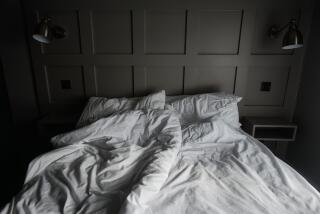Sleep apnea sparks a great awakening
- Share via
I recall with fondness the years prior to 1989 when I could take for granted my ability to fall asleep quickly and stay asleep for a full eight hours. After a car accident and subsequent surgeries, however, insomnia and its shiftless cousin, fatigue, settled in for an unwelcome stay -- that is, until recently.
I had talked with my doctor over the years about this problem. He offered me sleeping medications -- Ambien, Lunesta, Rozerem, Sonata -- but I happen to be one of those unlucky people who is highly sensitive to most kinds of meds, and these were no exception. Not only did I not sleep very well, but with each one I also suffered a bad hangover the next day.
After several years of trying many alternatives (acupuncture, herbs, meditation, blackout drapes) with poor results, I requested an overnight sleep study. My physician asked me if I snored; I didn’t. He asked me if I woke up gasping for air; I did not. “Well, then,” he said, “a sleep study isn’t indicated. Those are reserved for people who snore and possibly have sleep apnea.”
A year later, I told him I was getting desperate to find a cure for my insomnia, and again asked for a sleep study -- only this time, I stood up and raised my voice.
“OK,” he said, “but first I’ll refer you for a sleep apnea evaluation -- the kind that doesn’t require an overnight stay.” I was later sent home with a device I had to strap to my chest before bedtime. It included assorted attachments for measuring my heart rate and oxygen levels, and one for charting my movements as I tried to sleep.
The results? A diagnosis of severe obstructive apnea while sleeping on my back; moderate apnea while lying on my side.
To be fair to my doctor, I did not fit the typical picture of a person with sleep apnea. I’m not male, I’m not hypertensive or overweight and my neck is half the circumference of a linebacker’s. I do not raise the roof by snoring, and I don’t wake up frantic for breath. Yet I have sleep apnea.
While getting fitted for my CPAP (continuous positive airway pressure) machine, which delivers air pressure through the nose at night to keep the airway open, I learned that sleep apnea is more than just a nuisance. It’s a serious medical condition that can lead to heart disease, kidney disease and stroke. Although there are surgical options available for removing the excess tissue from one’s throat (the cause of the problem) I chose the noninvasive approach.
Finding a face mask I could tolerate, however, was much more difficult than getting used to the machine’s soft, hypnotic hum. The first one covered most of my face, and even though I recovered from the panic attacks it incited, I couldn’t tolerate the wrinkles it engraved under my eyes. The nose piece on the second mask easily slipped out of place and allowed gusts of air to stream toward my eyeballs.
On the third try, I found one that worked, and although I can’t say it has solved all my sleeping problems, I do feel less fatigued during the day.
When I slide into bed at night I may look like Hannibal Lecter in a snorkel mask, but it sure beats a heart attack and an ambulance ride to the hospital.
Rosie Sorenson is a former psychotherapist and writer living (and sometimes sleeping) in the Bay Area.






